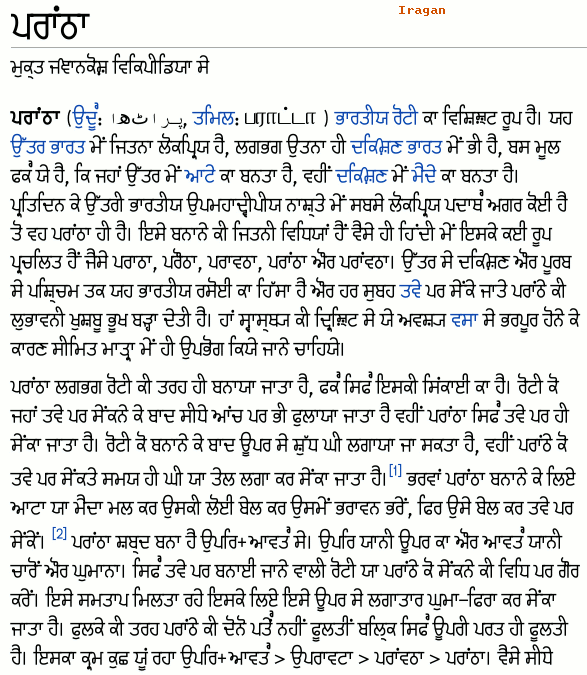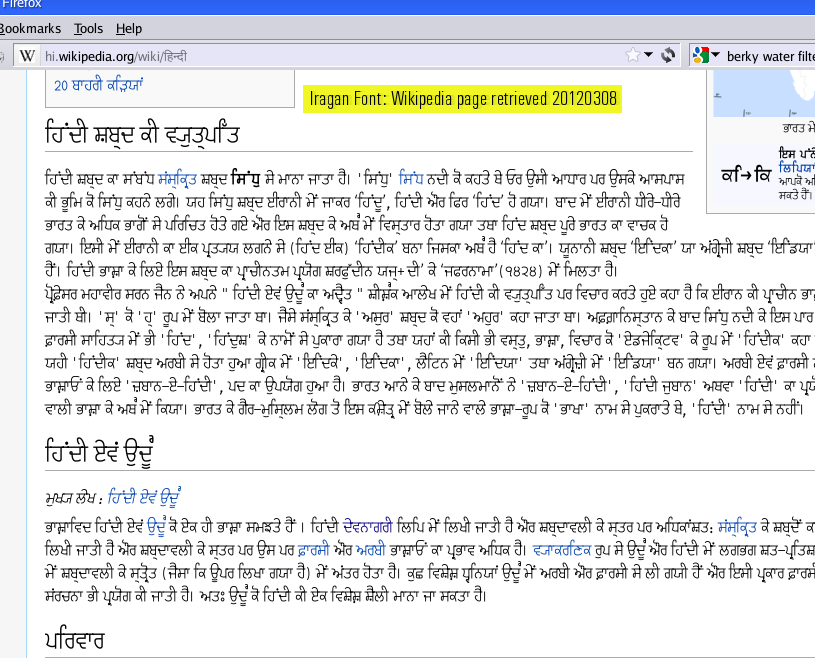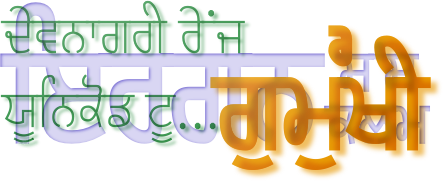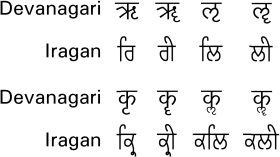
About Iragan . . .
Why Gurmukhi characters in the Devanagari range? . . .
There are many people who speak Hindi, cannot read Devanagari but can read Gurmukhi. Increasingly, many Hindi websites provide text in the Unicode Devanagari range although they do not produce a Punjabi/Gurmukhi translation/transliteration.
This is where Iragan steps in...
The Iragan font takes the Devanagari range but outputs Gurmukhi characters instead, thus a piece of text written in Devanagari (using Unicode) can easily be displayed as Gurmukhi, without having to install any extra program, simply by changing the font.
You can see from the glyph layout on the right that Roman characters appear in the Roman text area (pink) and Gurmukhi characters appear in the Gurmukhi text area (green). However, the thing that makes this font different is that in the Devanagari text area (yellow), Gurmukhi characters appear as well.
However, there are some additions because Devanagari has some additional vowel and other sounds that are mapped onto their close relatives from the Gurmukhi characters.
One thing that you have to remember is that when you are looking at a piece of Hindi text, coded in the UniCode Devanagari range but displayed as Gurmukhi:
This creates a few interesting issues that are dealt with by the font, that you just have to know about.
- you are still looking at Hindi, which is heavier in conjuncts (clusters of consonants grouped together without vowel sounds between them) and there are extra characters; and,
- it is rendered by the computer in the way that Devanagari is rendered.
Devanagari :: Overview
On the right, you can see the basic Devanagari alphabet, laid out in the same way that the Gurmukhi alphabet is laid out from the second row onwards, with the independent and dependent (based on क,ਕ) vowels and so on, finished off by the numbers from 1 to 9 and 0. In addition, you can see on the far-right the corresponding Gurmukhi characters and in the middle, you can see the renderings of the Devanagari characters on the left by the Iragan font - the Devanagari unicode text is simply copied across and the font changed, nothing else has happened to it.
One thing that you will notice is that in Devanagari, there are no ੜ or ੜ੍ਹ, being represented instead by the paer-bindi forms ड़ and ढ़.
Also, there are four extra independent vowels - ऋ ॠ ऌ ॡ - along with an example of the first as a dependent vowel with क to make कृ - the others being कॄ, कॢ and कॣ. These don't exist in Gurmukhi but are rendered by Iragan in Gurmukhi as their equivalents.
If you look at the isolated gap in the Gurmukhi layout on the right, on the 7th row, you will see another character that does not exist in Gurmukhi, although it occurs quite frequently in Devanagari so it is worth more than just a passing mention.
Devanagari :: Extra Letters
'ष' On the right, you can see in the bottom row, the characters 'ਹ', 'ਸ' and 'ਸ਼'.
If you lay your tongue flat long the bottom of your mouth and produce a sound, you have 'ਹ' - this corresponds to the position of your tongue in the letter 'ਕ'.
- If you bring the tip of your tongue up to your teeth and produce a sound, you have 'ਸ' - corresponding to the letter 'ਤ' - and,
- if you move that point further back still, you get 'ਸ਼' which corresponds to 'ਚ'.
In Devanagari, these correspond to ;ह, स and श. However, if you continue to move this point back, so that it corresponds with the letter ਟ, you get 'ष'. This is the letter that is missing in Gurmukhi (it simply isn't used in Punjabi) on the seventh row of the overview in the diagram above.
In keeping with the tradition of adding a paer-bindi to indicate that a sound is produced further back than the letter without it suggests, I have represented the ष 'Sh' by adding a paer-bindi to the appropriate character - although, this is a 'ਸ਼' which, of course, already has one so for this character in the Iragan font family, it has two and we gain an extra letter. Further to this, if someone is reading text using this font and doesn't know about this, they will probably read it as a ਸ਼ which is not going to be a problem for many people.
'ऋ' 'ॠ' 'ऌ' 'ॡ' In the diagram on the right, you can see four independent vowels and their dependent versions - just the like the other vowels.
Under each line, you can also see how the Iragan font translates the sounds that they make into Gurmukhi characters.
The independent vowel forms only appear in words that are derived from Sanskrit and the latter of them - 'ॡ' - does not appear in Sanskrit but is included for the sake of completeness.
You will only see characters such as 'ऋ' at the beginning of words, where it has the job of holding the vowel although you will see the dependent form all over the place.
In making the font, I have gone out of my way to anticipate occasions where the dependent form of 'ri' will be and make them appear in Gurmukhi. However, Devanagari is sufficiently complex to make it impossible (see Godel's Incompleteness Theorem) to predict all of them. With this in mind, if a situation arises where Iragan has no option but to produce the dependent form of ri', it will do so, in the Devanagari form - see Panegyrist in the conjuncts section below.
In addition, when the source text uses the Devanagari equivalent of a paer rarra, in a conjunct, followed by a sihari, the sihari appears at the beginning of the conjunct - the conjunct being indicated by the presence of a 'halant', the line under the consonant that slopes off the the lower-right. In the case of a conjunct that uses the dependent form of 'ri' the sihari appears before the last consonant in the conjunct, thus; for the example word 'script':
Note that Gurmukhi has always been able to do this but you never see it because conjuncts in Gurmukhi are reserved for trailing 'ਰ', 'ਹ', 'ਵ' and 'ਯ' with the latter being seen so infrequently that most people don't know it is there.
- स्कृप्त -> ਸ੍ਕ੍ਰਿਪ੍ਤ
- स्क्रिप्त -> ਸ੍ਕ੍ਰਿਪ੍ਤ
'ज्ञ' 'क्ष' Finally - at least as far as additional letters are concerned -
, there are two characters that are called 'Akhands' that are made from the sounds 'J' and 'Ny' - 'ज्ञ' - and 'K' and 'Sh' - 'क्ष'
They are typed by entering what are effectively conjunct sequences - you can see these in the diagram on the right - but the letter shape that you get gives little resemblance to the sound that is produced by the resulting characters.
In recognition of the fact that these are not ordinary conjuncts but instead, Akhands, I have produced the characters with a raised bar in the middle as you can see in the Iragan font example on the bottom line of the diagram so that you recognise that instead of JaNya and KaSha, you should produce the sound JNya and KSha.
It is difficult to find single-word examples of these in English (they are all over the place in Hindi) but if you think of the sound you would make when saying the words 'pig-newt' without a gap between them (you only get the beginning of the 'j' sound), thus 'पिज्ञूट'; and, the KSh in Yorkshire (pronounced 'Yauksha') as यौक्षा.
Finally, our new letter 'Sh' - ष - forms conjuncts with the letters in its row - ie, 'ट', 'ठ', for example.
To form a conjunct the vertical line on the right of the preceding character is removed - if it has one - to make what is called a 'half-form' and it is then stuck onto the letter it precedes, thus: 'ष्ट' and 'ष्ठ'. These two appear a lot in Hindi and Sanskrit and have their own characters in Iragan as you can see so that you know how to pronounce them.
Another letter that is not entirely predictable from its normal form is the regular 'Sh' - श. In a number of cases, it forms a ribbon-like structure such as in 'श्व' (assuming that you are not unfortunate enough to have loaded a font that does not do this).
You can see examples of this and font-to-font variations of other conjuncts on the right
Devanagari :: Conjuncts beginning with 'R' (ਰ) We have already mentioned conjuncts and that they are formed when two letters are joined together
without a vowel sound between them. However, there is still a special case where a conjunct forms that starts with a letter 'r'.
In Devanagari, this character appears as a right-facing curve, above the right-hand-side of the conjunct. In the example on the right, we have the five syllable-blocks required to form the word 'perspicuity'. The second of these blocks has the leading 'r' in it.
In order to read these blocks properly, you start with a leading 'r' (called a 'reph') if there is one, then you read the consonants in the block from left to right and then, you read any vowel sound that might replace the default 'a'.
Iragan uses the Devanagari part of Unicode so when it encounters a leading 'r' in a conjunct, it automatically places it at the end of the conjunct. So as to make life a bit easier and make it so that there is only a minimum of learning required to use this font to read Devanagari encoded text by displaying it as Gurmukhi, I have made the reph symbol look like a Gurmukhi 'r', ie ਰ, although it is positioned by your web browser at the end of the syllable as it would if it were Devanagari.
Devanagari :: Conjuncts As has already been mentioned, there are many conjuncts in Hindi and Sanskrit
and whilst the 'Dave' font transliterates from Gurmukhi to Devanagari where Adhaks, bindis and tippies are largely predictable, Iragan has to transliterate the other way so where, for example. an explicit bindi stays as a bindi, a half form of an explicit nasalisation has to become a bindi. However, so as to avoid the prospect of an incredibly large font file, bindis and tippies all appear as bindis - an inconvenience that only a few would complain of.
In Devanagari, geminates (Adhaks) are explicit so where they appear, they are converted into adhaks as you can see on the right.
On the right, you can see how Iragan renders Devanagari versions and compare them with the Gurmukhi version on the right. You can see that any differences are only minimal and do not hinder the reading of the text.
You can still see how conjuncts are formed by the fact that the halants have been left in, although that only becomes important where you have a sihari and you need to know where to pronounce it.
After a short while, you can word-read Hindi or Sanskrit with this font and you don't have to learn how to read Devanagari in order to do so.
Using Iragan In order to use Iragan in your web browser,
all you need to do, once you have installed it, is to go to your preferences form and select the section that allows you to change the fonts that your browser uses to display text.
Then, select the Devanagari code range.
Next, Select the Iragan font of your choice.
If you don't choose the 'Bold' weight, then when a web page selects 'bold text', it will be bolder than the rest of the text it displays.
Finally, either straight away or when you click on 'apply' or 'close' or some similarly-functioned button, the Iragan font should change your Devanagari text into Gurmukhi text.
That is all there is to it.
Click here to see an example of browser text in Hindi, displayed as Devanagari and as Gurmukhi, using Iragan.
Examples of pages used with Iragan . . .
click on the images to open them up full-sized in another tab...

Hover the mouse over the images below to show examples of font characters and weights
Download Iragan . . .
Download Iragan Sans Light TrueType font irgn_s_3.ttf 80,176 bytes Download Iragan Sans Book TrueType font irgn_s_4.ttf 76,904 bytes Download Iragan Sans Medium TrueType font irgn_s_5.ttf 76,052 bytes Download Iragan Sans Bold TrueType font irgn_s_7.ttf 72,992 bytes Download Iragan Kalam Light TrueType font irgn_k_3.ttf 106,160 bytes Download Iragan Kalam Book TrueType font irgn_k_4.ttf 110,240 bytes Download Iragan Kalam Medium TrueType font irgn_k_5.ttf 104,240 bytes Download Iragan Kalam Bold TrueType font irgn_k_7.ttf 105,488 bytes Have you got the latest version of one of these fonts? If you have just downloaded it from this site, you have. Otherwise, you can check any font file by comparing the hash function results of the file on your computer with the values in the list by clicking here for text file and here for a web page - opens in a new tab. Select the font file on your system and look at the properties. Compare the hash result against the values in the table. These pages are kept up-to-date so whenever I update a font or create a new one, it will be on there.
Download All Fonts
You can download all of the fonts from all of the font families on this site in one compressed archive by clicking here for a ZIP file
or here for a TAR.GZ file

If you want to make a contribution directly using PayPal, my email address is paul.alan.grosse@gmail.com and please include your name and if relevant, your company and the project so that they can be included on the contributors page with a link if appropriate.
To see a list of contributors, click here.
Thank you.
Copyright ©2007-2023 Paul Alan Grosse.

























